Heritage Boatworks, a Nation’s Oldest Port® program at the St. Augustine Lighthouse & Maritime Museum, just finished a Barca Chata, which is Spanish for flatboat. This simple flat-bottomed boat design saw widespread use in colonial America and continued through the beginning of the 20th century. Heritage Boatworks, a volunteer-run program dedicated to keeping the tradition of boatbuilding alive in St. Augustine, also made a separate Barca Chata, which was recently donated to Fort Mose Historic State Park for display.
Fort Mose was the first legal free African settlement in the U.S. and was comprised of previously enslaved Africans, many of whom made their way to freedom on plantation boats similar to the Barca Chata. This was the second Barca Chata presented to Fort Mose and one of a number built since the program was initiated in 2007 by the Lighthouse Archaeological Maritime (LAMP), the research arm of the Museum.
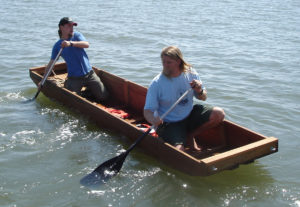
This Barca Chata or flatboat was built in 2008 by Heritage Boatworks. During this first sea trial, onboard were former LAMP Associate Director Brendan Burke (back) and LAMP Director Chuck Meide (front).
St. Augustine, Florida, was founded in 1565 by the master mariner Pedro Menéndez de Avilés, the adelantado of La Florida, Spain’s vast northern frontier territory. Historians and archaeologists alike have long portrayed St. Augustine as a poor, struggling military outpost on the fringe of the empire. However, the famed historian Eugene Lyon’s archival research has shown that the settlers and soldiers in our town carried out many enterprises, trades, and economic activities. Many produced commodities for both local sale and export and had access to a surprisingly wide array of goods through maritime commerce. Boats and ships were vitally important to the nascent settlements in La Florida for defense, maintaining communication lines, trade links with each other, and the more established Spanish colonies further south.
Shipping records translated by Lyon indicate the regular arrival and departure of Chalupas, Zabras, Fragatas, Navíos, Pataches, Caravels, Barca Chatas, and the occasional Urca and Bergantín, directly from Spain and also from Española (present-day Haiti/Dominican Republic), Cuba, and Yucatan (in Mexico). They brought diverse hardware, foodstuffs, wine, livestock, cloth, tools, household items, and other goods ranging from cordovan leather boots to velvet caps. Notable among the supplies arriving from Spain were tools and materials that could be used for shipbuilding and sailmaking.
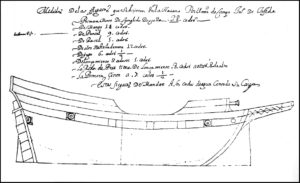
Drawing of a “Fragata,” or Frigate, from a Spanish document dated around 1600. Pedro Menéndez used these small, fast vessels to patrol the coasts of La Florida.
There is more evidence for shipbuilding in La Florida. Menéndez had proposed to the King that he build 20 Fragatas to patrol the coasts of La Florida. This seems to have never come to fruition, but he did have a Fragata built at St. Augustine and another at Santa Elena, launched in August 1572. In addition, former LAMP archaeologist Sam Turner’s analysis of the Baptiste Boazio map, showing Drake’s 1586 raid of St. Augustine, which was published in 1589, has led him to believe that a simple structure depicted with a roof on five pairs of large posts is most likely a boat building shed. This possible boat building shed is located on the bayfront adjacent to the Fort (a previous wooden version of today’s Fort) and a few ancillary buildings, a suitable and protected location for building and launching small vessels.
Anchored just offshore is a small Fragata-like vessel, which the map’s legend describes as a “pinnace,” a general English term for a small craft often with a military purpose, “lying hard by their fort.” The 1593 Mestas map shows roughly the same area seven years after Drake’s devastating attack. The boatbuilding operation has presumably been moved, like a palisade defending the town’s waterfront would now impede launchings. Still, a pier extends into the bay, and tied off to it are what appears to be a Fragata, and two small craft, either dugout canoes (Canoas) or small flatboats (Barcas Chatas).
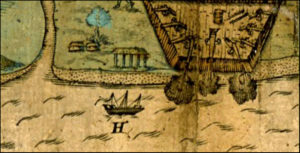
Detail from the 1589 Boazio map of St. Augustine, showing the St. Augustine waterfront with a timber fort (a precursor to the Castillo de San Marcos) as it appeared in 1586. To the left of the Fort is a simple structure consisting of a roof suspended by timber poles, which is believed to represent a boatbuilding shed. Directly offshore is a small Fragata-like vessel labeled by the English as a pinnace.
In 2008, LAMP conducted historical research at the Archivo General de Indias (“General Archive of the Indies”) in Seville. Of principal interest were the records in the Caja de San Agustín de Florida, the “St. Augustine Box,” many of which were translated by former LAMP archaeologist Sam Turner. In addition, the Cuentas de Bastimentos, or supply accounts, lend insight into maritime activity in St. Augustine at the close of the 16th century. These supply records indicate a group of small but seaworthy craft stationed at St. Augustine under the supervision of a managing pilot, who was supervised by the chief pilot for the entire province of La Florida.
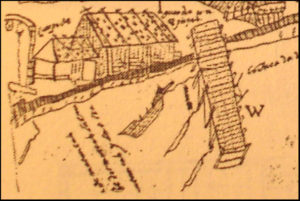
Detail from the 1593 Mestas map of St. Augustine’s waterfront. A defensive palisade or wooden wall has been erected to protect the town from a seaborne attack, a measure taken since Drake’s raid in 1586. A dock is shown with three vessels tied off to it, including a Fragata and two smaller craft representing either canoes or Barcas Chatas. Another canoe or Barca Chata is tied off from the beach to the left of the image.
The largest vessels were two Fragatas named La Concepción and San Andres, though it is not certain if either was built there or in Havana. We don’t know how large these were, but because of St. Augustine’s shallow and treacherous entrance, they were likely small, perhaps around 50 tons. In October 1597, supplies were requested to prepare La Concepción for an attack on the Guale Indians in present-day Georgia in retaliation for the murder of some Franciscan friars stationed there.
Two months later, the sailing thread was ordered for a newly built chalupa (shallop), and a similar order was made for another chalupa built-in St. Augustine in 1601. That same year, an order of 50 timbers was delivered from New Spain to the master of the Fragata San Andres for repairs or maintenance. These requisitions indicate that St. Augustine had an active shipbuilding industry at the close of the century.
The “St. Augustine Box” documents also mention several other vessels stationed at St. Augustine 1597-1601 in service of the Spanish Crown:
- Two canoas (dugout canoes)
- A felibote (flyboat or fluit) named Nuestra Señora de Regla
- A bergantín named San Felipe
- A lancha (launch) named La Florida
One canoe was stationed at the watchtower guarding the St. Augustine Inlet, which was the precursor to today’s St. Augustine Lighthouse. The other canoe served a second watchtower at the Matanzas Inlet, the next inlet to the south, and the “back door” to St. Augustine. This wooden tower was a precursor to the small Fort Matanzas, which was built around the 1730s. A sail inventory indicates the Lancha named La Florida had two masts and probably square sails. Nuestra Señora de Regla as a Felibote was a Dutch vessel type and probably originated in Spain’s possessions in the Netherlands. The type was known for flat bottoms designed to navigate shoal waters and so would have been well-suited for St. Augustine’s inlet.
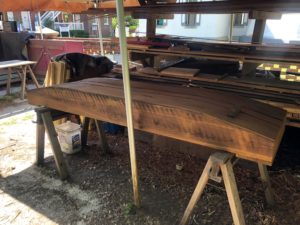
The recently completed Barca Chata, Spanish for flatboat, built by Heritage Boatworks at the St. Augustine Lighthouse & Maritime Museum in 2021. This is similar to the St. Augustine Barca Chata documented in 1602.
A similar inventory from another document dated 1602 includes a Fragata named San Joseph, a Barca Chata, a Batel Pequeño (small boat), a Falua (gig or tender), a Chalupa, and a Canoa Mediano (medium-sized canoe) made here in this province, which acts as a sentinel off the bar, and a small canoe made here.”
In addition to the Barca Chatas built here at the Museum, LAMP archaeologists and Heritage Boatworks helped design and make an authentic chalupa in time for St. Augustine’s 450th anniversary in 2015. This project was spearheaded by our partner, the St. Augustine Maritime Heritage Foundation. The boat was built at the Fountain of Youth Archaeological Park, where it can be seen today.
A chalupa, known in English as a “shallop,” is essentially an undecked longboat propelled by oars or sail. They can be relatively small, used as tenders or whaleboats, or quite large. We know some sizable examples (probably at least partially decked) of up to 80 tons reported, having arrived in St. Augustine directly from Spain. The chalupa built-in St. Augustine was based on archaeological and historical data compiled by LAMP archaeologists, and it measured 37.66 feet in length and 8.95 feet in breadth. It was equipped with two masts and ten oars.
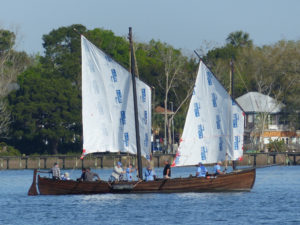
The replica Chalupa built by the St. Augustine Maritime Heritage Foundation with the assistance of LAMP research in 2015.
The replica chalupa sails well with a strong wind and can still make headway with a light breeze even against the notoriously strong tidal currents in St. Augustine’s inland waters. The Barca Chata replicas we have made are much smaller boats, which could be equipped with a sail but were more likely paddled or poled. Even though they are small, Barca Chatas are remarkably stable and made solid workboats or cargo carriers on our inland waters.
The heritage boatbuilding carried out here at the Museum, informed by LAMP’s ongoing research, helps keep these lost arts alive. It also gives us insight into what these crafts would have been like to sail and maneuver in the time when the St. Augustine Lighthouse was a wooden tower and when Florida was the northernmost extent of Spain’s New World empire.

